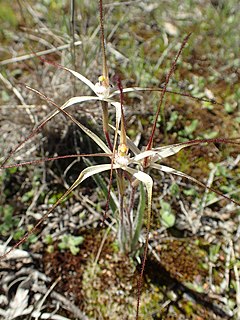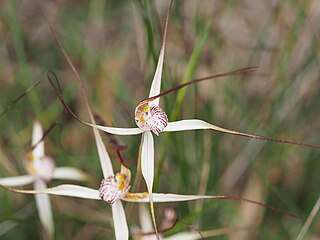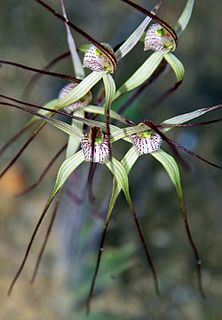
Caladenia dimidia, commonly known as the chameleon orchid is a species of orchid endemic to the south-west of Western Australia. It has a single hairy leaf and one or two yellow, cream-coloured or pinkish flowers. It is a variable species, similar to the Joseph's spider orchid but has a more northerly distribution and smaller flowers.
Caladenia abbreviata, commonly known as the coastal spider orchid, is a plant in the orchid family Orchidaceae and is endemic to the south-west of Western Australia. It has a single erect, hairy leaf and up to three pale, creamy-yellow flowers on a flowering stem up to 35 cm (10 in) high. Although the flowers have long, thread-like petals and sepals, they are shorter and darker than those of other spider orchids. It is a rare, relatively recently discovered species although often found near human activities.

Caladenia cruscula, commonly known as the reclining spider orchid is a species of orchid endemic to a small area in the south-west of Western Australia. It has a single hairy leaf and a single cream-coloured flower with a long red fringe on the sides of its labellum.
Caladenia denticulata subsp. albicans, commonly known as the alabaster spider orchid, is a plant in the orchid family Orchidaceae and is endemic to the south-west of Western Australia. It has a single erect, hairy leaf and one or two pale creamy-white flowers which have a white labellum with red markings. The only known population occurs in a small area near Arrowsmith.

Caladenia dundasiae, commonly known as the Patricia's spider orchid and Dundas spider orchid is a species of orchid endemic to a small area in the south-west of Western Australia. It is a rare orchid with a single hairy leaf and one or two, usually red flowers with thin, stiffly-held lateral sepals and petals.

Caladenia erythronema, commonly known as the red thread spider orchid, and Nyabing spider orchid is a plant in the orchid family Orchidaceae and is endemic to the south-west of Western Australia. It has a single hairy leaf and up to three red, yellow or cream-coloured flowers with dangling, thread-like sepals and petals and a small labellum.
Caladenia evanescens, commonly known as the semaphore spider orchid, is a species of orchid endemic to a small area near Albany in the south-west of Western Australia. It is a rare species with a single, hairy leaf and one or two cream-coloured to greenish-cream flowers.

Caladenia excelsa, commonly known as the giant spider orchid, is a species of orchid endemic to a small area in the south-west of Western Australia. It is a rare species with a single, hairy leaf and up to three cream-coloured to greenish-cream flowers with long, drooping sepals and petals. It is one of the tallest spider orchids in Western Australia and, with Caladenia splendens, has the largest flowers of any Western Australian orchid.
Caladenia harringtoniae, commonly known as the pink spider orchid, is a species of orchid endemic to the south-west of Western Australia. It has a single, hairy leaf and up to three pale to deep pink flowers which have a cream-coloured labellum with a pink tip.

Caladenia horistes, commonly known as the cream spider orchid is a species of orchid endemic to the south-west of Western Australia. It has a single, hairy leaf and one or two, creamy-yellow flowers which have a red-striped labellum and long, dark, thread-like tips on the sepals and petals.

Caladenia longicauda subsp. rigidula, commonly known as the rigid white spider orchid or island white spider orchid, is a plant in the orchid family Orchidaceae and is endemic to the south-west of Western Australia. It has a single hairy leaf and up to three large, mainly white flowers with relatively short lateral sepals and petals. It is similar to the reclining white spider orchid but that species has smaller, cream-coloured flowers.
Caladenia luteola, commonly known as the lemon spider orchid, is a species of orchid endemic to the south-west of Western Australia. It has a single, hairy leaf and up to three lemon-yellow flowers with red stripes on the labellum. It is only known from two small populations near Woodanilling.
Caladenia meridionalis, commonly known as the south coast spider orchid, is a species of orchid endemic to the south-west of Western Australia. It is an early-flowering orchid with a single erect, hairy leaf and one or two white flowers with long, drooping lateral sepals and petals.

Caladenia paradoxa, commonly known as the ironcaps spider orchid, is a species of orchid endemic to the south-west of Western Australia. It has a single erect, hairy leaf and up to three small creamy-white flowers. It was previously thought to be the same species as the eastern Australian Caladenia flaccida but is now recognised as distinct.

Caladenia pendens subsp. pendens, commonly known as the pendant spider orchid, is a plant in the orchid family Orchidaceae and is endemic to the south-west of Western Australia. It has a single hairy leaf and up to three relatively large, creamy-white flowers with long drooping petals and sepals and sometimes has a sickly-sweet scent.
Caladenia pluvialis, commonly known as the Yuna spider orchid, is a species of orchid endemic to the south-west of Western Australia. It is a common spider orchid, especially after winter rains, occurring in a restricted area. It has a single hairy leaf and one or two creamy-coloured flowers. It was formerly included with Caladenia incensa.

Caladenia polychroma, commonly known as the Joseph's spider orchid, is a species of orchid endemic to the south-west of Western Australia. It has a single erect, hairy leaf and one or two relatively large and colourful but smelly flowers.
Caladenia sigmoidea, commonly known as the sigmoid spider orchid, is a species of orchid endemic to the south-west of Western Australia. It has a single erect, hairy leaf and usually only one red and cream-coloured flowers with an unusual S-shaped labellum.

Caladenia vulgata, commonly known as the common spider orchid, is a species of orchid endemic to the south-west of Western Australia. It is a relatively common and widespread orchid with a single erect, hairy leaf and up to three creamy-white flowers. There is some variation in the species, both in flower colour and growth habit.

Caladenia wanosa, commonly known as the Kalbarri spider orchid, is a species of orchid endemic to the south-west of Western Australia. It has a single erect, hairy leaf and one or two cream-coloured flowers with red stripes. It is common but only in a restricted area of the state.














